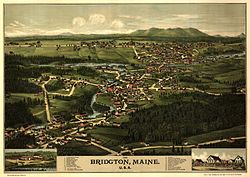2010 census
As of the census [13] of 2010, there were 5,210 people, 2,240 households, and 1,431 families living in the town. The population density was 91.7 inhabitants per square mile (35.4/km2). There were 4,051 housing units at an average density of 71.3 per square mile (27.5/km2). The racial makeup of the town was 96.6% White, 0.7% African American, 0.4% Native American, 0.3% Asian, 0.2% from other races, and 1.7% from two or more races. Hispanic or Latino of any race were 1.2% of the population.
There were 2,240 households, of which 24.5% had children under the age of 18 living with them, 48.7% were married couples living together, 10.4% had a female householder with no husband present, 4.8% had a male householder with no wife present, and 36.1% were non-families. 28.9% of all households were made up of individuals, and 12.1% had someone living alone who was 65 years of age or older. The average household size was 2.24 and the average family size was 2.71.
The median age in the town was 46.8 years. 18.6% of residents were under the age of 18; 8.4% were between the ages of 18 and 24; 20.2% were from 25 to 44; 33% were from 45 to 64; and 19.8% were 65 years of age or older. The gender makeup of the town was 49.2% male and 50.8% female.
2000 census
As of the census [14] of 2000, there were 4,883 people, 1,924 households, and 1,296 families living in the town. The population density was 85.2 inhabitants per square mile (32.9/km2). There were 3,063 housing units at an average density of 53.5 per square mile (20.7/km2). The racial makeup of the town was 97.36% White, 0.47% Black or African American, 0.27% Native American, 0.27% Asian, 0.23% from other races, and 1.41% from two or more races. Hispanic or Latino of any race were 0.82% of the population.
There were 1,924 households, out of which 29.7% had children under the age of 18 living with them, 51.4% were married couples living together, 11.4% had a female householder with no husband present, and 32.6% were non-families. 25.8% of all households were made up of individuals, and 11.3% had someone living alone who was 65 years of age or older. The average household size was 2.50 and the average family size was 2.85.
In the town, the population was spread out, with 22.1% under the age of 18, 10.5% from 18 to 24, 25.9% from 25 to 44, 25.6% from 45 to 64, and 15.9% who were 65 years of age or older. The median age was 40 years. For every 100 females, there were 100.3 males. For every 100 females age 18 and over, there were 98.2 males.
The median income for a household in the town was $36,722, and the median income for a family was $42,392. Males had a median income of $29,614 versus $21,548 for females. The per capita income for the town was $17,352. About 9.3% of families and 15.7% of the population were below the poverty line, including 12.6% of those under age 18 and 4.8% of those age 65 or over.







